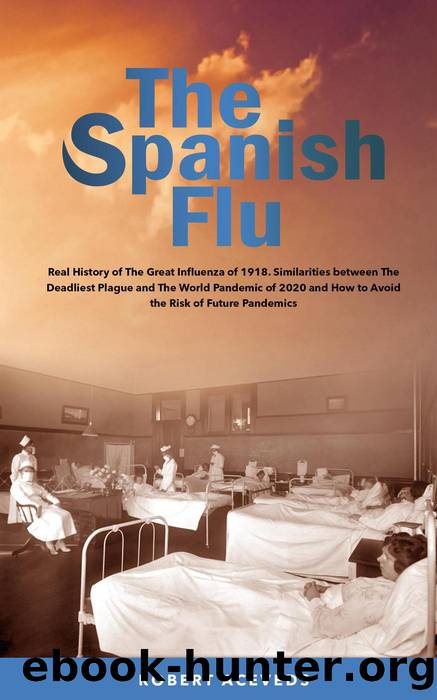The Spanish Flu--Real History of the Great Influenza of 1918. Similarities between the Deadliest Plague and the World Pandemic of 2020 and How to Avoid the Risk of Future Pandemics by Robert Aceveds

Author:Robert Aceveds
Language: eng
Format: epub
Tags: nursing, pandemic history, pandemic, pandemic 2020, pandemic 1918
Publisher: Robert Aceveds
Published: 2020-09-22T00:00:00+00:00
COVID-19
A novel strain of coronavirus â SARS-CoV-2 â was first identified in December 2019 in Wuhan, a town in Hubei province of China with 11 million inhabitants, following an outbreak of pneumonia without an apparent cause. The virus has currently spread across the globe to more than 200 countries and territories, and the World Health Organization (WHO) described it as a pandemic on March 11, 2020.
As of September 1, 2020, there were 25,298,875 laboratory-confirmed cases of 2019 coronavirus disease (COVID-19) infection worldwide, with 847,602 deaths recorded. On March 16, 2020, the number of cases and deaths outside of China overtook those within the country.
It is too early to say how the epidemic of COVID-19, which has already infected about 2 million people and killed more than 126,000 people, will change the planet. However, the epidemic has seen nations, both democratic and dictatorial, place draconian limits on the people's movements. The western world, the center of the post-World War order, lies exposed to the virus attack. The US unemployment rate has risen to levels unknown since the end of World War II. Governments worldwide, including the US administration, are stepping up spending to support an economy showing signs of stagnation. Drastic changes, good or bad, are already occurring.
There were 335,873 confirmed cases of the virus in the UK as of August 31, 2020, and 41,501 of them died (within 28 days of the test).
What is Coronavirus?
SARS-CoV-2 belongs to the coronaviridae family of single-stranded RNA viruses, a common virus that affects mammals, birds, and reptiles.
It normally triggers mild infections in humans, similar to the common cold, and accounts for 10â30 percent of adult upper respiratory tract infections. More severe infections are uncommon, although coronaviruses can cause neurological and enteric disease. A coronavirus' incubation time varies but usually lasts for up to two weeks.
Previous outbreaks of coronavirus include the Middle East respiratory syndrome (MERS), first recorded in Saudi Arabia in September 2012, and extreme acute respiratory syndrome (SARS), found in southern China in 2003. MERS infected some 2,500 people and resulted in more than 850 deaths, while SARS infected more than 8,000 people and resulted in almost 800 deaths. For these cases, the case fatality rates were 35 percent and 10 percent, respectively.
SARS-CoV-2 is a new type of coronavirus previously unrecognized in humans. Although the incubation period for this strain is currently unclear, it is indicated by the United States Centers for Disease Control and Prevention that symptoms can occur in as little as two days or as long as 14 days after exposure. Chinese researchers have indicated that SARS-CoV-2 can become infectious during its time of incubation.
On March 16, 2020, the number of cases and deaths outside of China overtook those within it.
Where has the new coronavirus come from?
Where the virus originated is still unknown. The virus was originally believed to originate in Wuhan's food market and then spread from animal to human. Some research has suggested that transmission between snake and human may be cross-species; however, this argument has been contested.
Mammals
Download
This site does not store any files on its server. We only index and link to content provided by other sites. Please contact the content providers to delete copyright contents if any and email us, we'll remove relevant links or contents immediately.
Periodization Training for Sports by Tudor Bompa(8096)
Why We Sleep: Unlocking the Power of Sleep and Dreams by Matthew Walker(6556)
Paper Towns by Green John(5022)
The Immortal Life of Henrietta Lacks by Rebecca Skloot(4447)
The Sports Rules Book by Human Kinetics(4213)
Dynamic Alignment Through Imagery by Eric Franklin(4050)
ACSM's Complete Guide to Fitness & Health by ACSM(3937)
Kaplan MCAT Organic Chemistry Review: Created for MCAT 2015 (Kaplan Test Prep) by Kaplan(3906)
Introduction to Kinesiology by Shirl J. Hoffman(3699)
Livewired by David Eagleman(3623)
The River of Consciousness by Oliver Sacks(3498)
The Death of the Heart by Elizabeth Bowen(3483)
Alchemy and Alchemists by C. J. S. Thompson(3422)
Bad Pharma by Ben Goldacre(3208)
Descartes' Error by Antonio Damasio(3188)
The Emperor of All Maladies: A Biography of Cancer by Siddhartha Mukherjee(3025)
The Gene: An Intimate History by Siddhartha Mukherjee(3014)
The Fate of Rome: Climate, Disease, and the End of an Empire (The Princeton History of the Ancient World) by Kyle Harper(2975)
Kaplan MCAT Behavioral Sciences Review: Created for MCAT 2015 (Kaplan Test Prep) by Kaplan(2903)
